—Redirecting a fabulous flow where you can see and hear it

A reverse infinity swimming pool boasts a “vanishing” edge that faces the home and patio area so you can see the decorative wall with overflowing water and catch basin—versus being hidden from view on the pool’s far side where it appears to merge into the horizon.
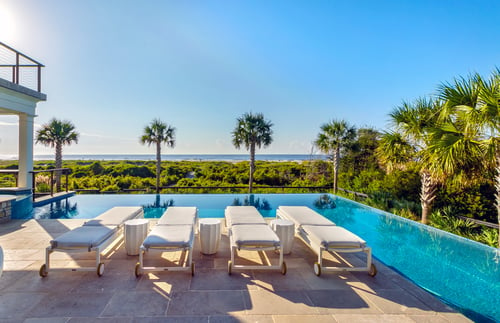
Newer on the pool-building scene, this inventive twist on the iconic infinity design is unfamiliar to many homeowners.
By “flipping” the infinity pool concept (aka “vanishing-,” “negative-,” or “zero-” edge pool), you create a new kind of visual and auditory treat in the backyard.
In this configuration, the special edge is turned around: Instead of the water traveling over the wall into a catch basin where no one can see it, the configuration is oriented on the accessible side of the pool; this means it is in full view of anyone around the patio and pool deck area.
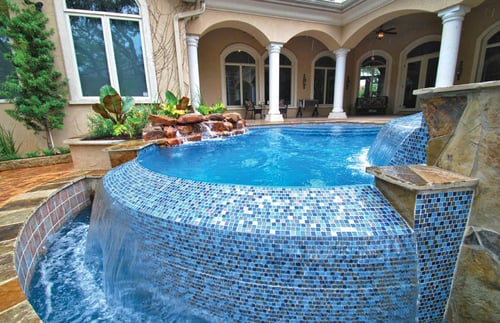
As it does in the traditional infinity design, the overflowing water sheets down the edge wall and into a catch basin, where it’s recirculated into the pool above it.
But the difference is that you can watch the water as it makes its journey over the decorative wall and fall into the basin.
By orienting the infinity side of the pool toward the house or trafficked patio area, the overflowing wall and basin make a grand appearance—versus “disappearing” into the horizon.
Sometimes referred to as a “water wall,” the design presents itself as an aquatic architectural creation, the kind you might see at the entrance of high-end resorts.
A variation is where the feature is not truly reversed, but exposed.
While the infinity wall and basin are situated on the far side of the pool and facing away from the home, they are easily accessible from the deck area and are designed with aesthetics in mind.
Maximizing sights and sounds
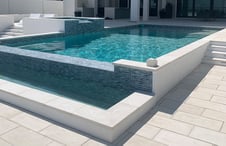
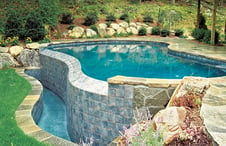
With its expanse of wall and catch basin in clear view, a reverse infinity edge boasts superb decorative possibilities. The same goes for a traditional infinity where the wall and basin occupy space adjacent to usable patio areas.
Starting with the surface of the exposed section of the pool wall, you have an ideal backdrop to showcase distinctive finish materials.
One approach is to use pool tile in your choice of head-turning color, pattern, and finish. On a pool with a modern aesthetic, a sleek, tile-covered wall usually compliments the look.
The other favorite tactic is to adorn the wall with distinctive flagstone or stacked ledger stone.
By using a textured stone surface—especially if it's stacked—the descending water is “invigorated”: Its flow takes on a complex character as it makes contact with the irregular contours of the stone pieces.
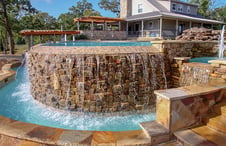

Indeed, the catch basin itself can also become a bold style statement.
Like the finishing material on the wall surface, the tile or stone inside and around the basin takes on greater visual significance since it is closer to the house and will be seen more often.
On some reverse or exposed infinity pools, the basin is downplayed. Its opening is only a narrow slot.
But on most jobs, designers capitalize on the basin to produce added liquid drama. The structure becomes a prominent element in the configuration.


As the water falls from the infinity wall and hits the shallow water in the basin, you have two additional effects.
One is for the eyes, with the two bodies of water meeting in motion. And the resulting sound is a relaxing sensation for your ears.
An infinity wall typically spans six feet or more feet of the pool perimeter. The basin, which runs the entire length of the infinity section, also represents an opportunity for added functionality.
If the basin width is at least two to three feet, it creates a shallow area—a virtual secondary pool that serves as a kind of kiddy play pool.
On particularly ambitious projects, the basin can boast enough square footage to give the main, upper pool a run for its money in terms of scale. On elaborate builds, an extra-spacious basin can even achieve a distinctive split-level effect.
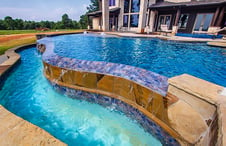

A daytime and evening attraction
Designers often locate a reverse infinity pool to takes advantage of views from surrounding decks and patios.
In some settings, this location is visible from inside the house. The captivating infinity water wall draws your gaze through a window, allowing you to enjoy the stylish aquatic creation even when you are not outside.
And if the wall faces your home and patio where people enter the backyard, it provides a “reveal” opportunity: Because the decorative structure obscures much of the pool from view, the result is an “ah-ha” moment when visitors walk to the main pool area and see the pool in its entirety.
In other backyards, the backside/downhill side of the infinity pool becomes a veritable “surprise destination.”
For example, the hardscape layout may include a path or stairs that lead you to the far side of the pool to discover the outward-facing edge wall and catch basin to enjoy.
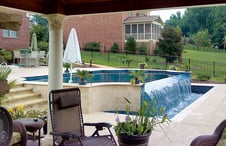

After dark, a reverse or exposed infinity edge delivers handsome good looks as well.
The feature is ideal for color-changing LED up-lighting to accentuate the structure in vibrant whites, blues, pinks, greens, and more.
As the light catches the water traveling down the wall surface, the result is a sophisticated backyard showstopper.

Reverse and exposed infinity designs can be used in especially clever ways.
For example, this innovative design can provide a unique backdrop for an intimate conversation area with a backyard fire pit where you can enjoy the sights and sounds of the moving water up close.
The infinity edge and basin could even serve an attractive water hazard for a putting green!
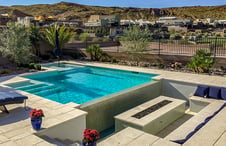
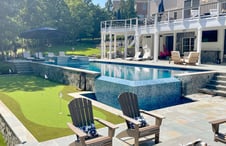
To make the infinity edge even more attention-getting, you can integrate landscape, hardscape, and water features.
For example, an extended landscape strip could run adjacent to the infinity edge to amplify it presence.
Or, you could bookend the wall with eye-catching planter boxes or pilasters topped with fire features.


Yet another trick is to incorporate deck jets or laminars to punctuate the surface of the overflowing water for a stunning display.
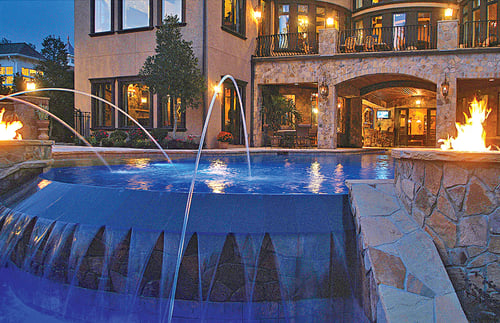
Traditional or reverse?
Which kind of infinity pool is the best choice for your backyard setting?
Deciding whether to go with a conventional or a reverse-edge version often comes down to a property’s topography. Would it allow for an elevation change between the pool edge and the catch basin below it?
In some cases, the grade change is only a foot or two; on steeper lots, the edge might be six to eight feet—or even taller.
Another key consideration: Does your backyard have a view? Will your pool be perched on a cliff, ravine, hillside, canyon, greenbelt, or overlooking a body of water such as a bay, lake, inlet, or ocean?
If so, the iconic version with an edge that “melts” into the expansive vista will usually be the way to go.

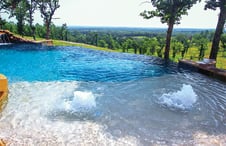
But on a property that has a slope that’s pitched back toward your home, doing the exact opposite may be worthwhile.
Now, it’s worth noting: If your property’s elevation and size allow for it, you may be able to have the best of both worlds: The mesmerizing infinity effect on the horizon and an exposed infinity wall and basin as an eye-catching amenity.
You can do so by extending the deck area to the far side of the pool. This way, the traditionally positioned infinity wall is available to enjoy by strolling over to this section of patio.
For a completely flat, enclosed yard, either infinity type is often a poor choice. Ask your designer about exceptions to this general rule. But ask only if you’re willing to splurge for either an enormous amount of grading to change yard elevations or for an above-grade pool configuration (a gunite shell that’s built fully out of the ground—instead of beneath it).
Choosing a builder for your infinity pool
Finally, take note that infinity edge pool construction is not for novice builders. These intricate projects demand multiple hydraulic and structural considerations.
For example, the size and depth of the catch basin will be largely dictated by some fairly sophisticated “water-in-transit” calculations. Knowledgeable contractors make sure to properly size basins to ensure adequate circulation of captured fallen water back into the pool.
So, if you plan a pool with an infinity edge—regardless of which way it will face—always work with a contractor experienced in these challenging projects.
When designed and built correctly, you’ll find the creative possibilities and the pleasures of owning one of these special pools is, well, almost infinite!
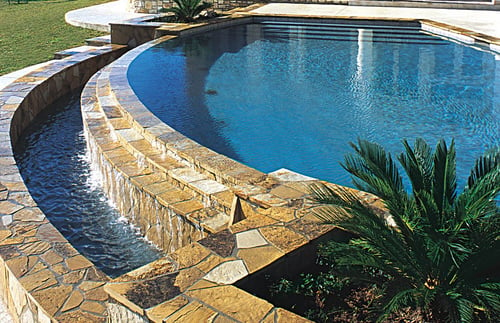




.jpg?width=1490&name=rock-waterfall-slide-pool%20(1).jpg)